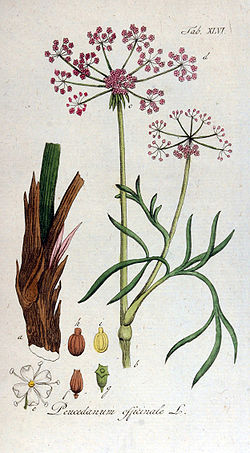| Former accepted name | Year assigned | Currently accepted name | Year reclassified | Additional synonyms in genus |
|---|
| Peucedanum abyssinicumVatke [7] | 1876 | Afrosciadium abyssinicum (Vatke) P.J.D.Winter | 2008 | Peucedanum silaifoliumHiern (1877) |
| Peucedanum afrumMeisn. [8] | 1987 | Afrosciadium afrum (Meisn.) P.J.D.Winter | 2008 | Peucedanum connatumE.Mey. ex Sond. (1862)
Peucedanum meisnerianumMacOwan ex Engl. (1921) |
| Peucedanum angustisectum(Engl.) Norman | | Lefebvrea angustisecta Engl. | | |
| Peucedanum articulatumC.C.Towns. [9] | 1987 | Afrosciadium articulatum (C.C.Towns.) P.J.D.Winter | 2008 | |
| Peucedanum camerunenseJacq.-Fél. | | Lefebvrea angustisecta Engl. | |
| Peucedanum dispersumC.C.Towns. [10] | 1987 | Afrosciadium dispersum (C.C.Towns.) P.J.D.Winter | 2008 | |
| Peucedanum dissectum(C.H.Wright) Dawe, nom. illeg. [11] | 1906 | Afrosciadium kerstenii (Engl.) P.J.D.Winter | 2008 |
| Peucedanum englerianumH.Wolff [12] | 1927 | Afrosciadium englerianum (H.Wolff) P.J.D.Winter | 2008 | |
| Peucedanum eylesiiC.Norman [13] | 1932 | Afrosciadium eylesii (C.Norman) P.J.D.Winter | 2008 | |
| Peucedanum falcariaTurcz. [14] | 1832 | Haloselinum falcaria (Turcz.) Pimenov | 2012 | Peucedanum priceiN.D.Simpson (1913)
Peucedanum salsugineumKrylov (1903) |
| Peucedanum friesiorumH.Wolff [15] | 1927 | Afrosciadium friesiorum (H.Wolff) P.J.D.Winter | 2008 | Peucedanum aberderenseH.Wolff (1927) |
| Peucedanum galbanum(L.) Magee [16] | 1898 | Notobubon galbanum (L.) Drude | 2008 | Peucedanum galbanum var. dentatumKuntze (1898)
Peucedanum galbanum var. incisodentatumKuntze (1898)
Peucedanum rhombifoliumStokes (1812) |
| Peucedanum gossweileriC.Norman [17] | 1922 | Afrosciadium gossweileri (C.Norman) P.J.D.Winter | 2008 | |
| Peucedanum harmsianumH.Wolff [18] | 1927 | Afrosciadium harmsianum (H.Wolff) P.J.D.Winter | 2008 | Peucedanum canaliculatumVerdc. (1954) |
| Peucedanum kersteniiEngl. [19] | 1894 | Afrosciadium kerstenii (Engl.) P.J.D.Winter | 2008 | Peucedanum dissectum(C.H.Wright) Dawe (1906)
Peucedanum mildbraediiH.Wolff (1912)
Peucedanum wrightiiM.Hiroe (1979) |
| Peucedanum kupenseI.Darbysh. & Cheek | | Lefebvrea angustisecta Engl. | |
| Peucedanum ledebourielloidesK.T.Fu [20] | 1981 | Pseudopeucedanum ledebourielloides (K.T.Fu) C.K.Liu & X.J.He | 2023 | |
| Peucedanum lundenseCannon [21] | 1970 | Afrosciadium lundense (Cannon) P.J.D.Winter | 2008 | |
| Peucedanum lynesiiC.Norman [22] | 1936 | Afrosciadium lynesii (C.Norman) P.J.D.Winter | 2008 | |
| Peucedanum magalismontanumSond. [23] | 1862 | Afrosciadium magalismontanum (Sond.) P.J.D.Winter | 2008 | Peucedanum schlechteriEngl. (1921)
Peucedanum schlechterianumH.Wolff (1912) |
| Peucedanum natalense(Sond.) Engl. [24] | 1921 | Afrosciadium natalense (Sond.) P.J.D.Winter | 2008 | |
| Peucedanum nyassicumH.Wolff [25] | 1912 | Afrosciadium nyassicum (H.Wolff) P.J.D.Winter | 2008 | Peucedanum doctorisC.Norman (1928) Peucedanum monticolaC.Norman (1928) |
| Peucedanum silausL. [26] | 1753 | Silaum silaus (L.) Schinz & Thell. | 1915 |
| Peucedanum platycarpumSond. [27] | 1862 | Afrosciadium platycarpum (Sond.) P.J.D.Winter | 2008 | |
| Peucedanum rhodesicumCannon [28] | 1976 | Afrosciadium rhodesicum (Cannon) P.J.D.Winter | 2008 | |
| Peucedanum trisectumC.C.Towns. [29] | 1976 | Afrosciadium trisectum (C.C.Towns.) P.J.D.Winter | 2008 | |
